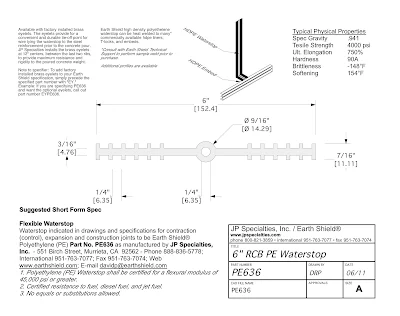Sunday, August 11, 2013
Sunday, June 02, 2013
Concrete Joints Defined
Saturday, March 23, 2013
We're Moving
J P Specialties, Inc.
25811 Jefferson Avenue
Murrieta, CA 92562
Ph: 951-763-7077
Fax: 951-763-7074
Web: www.jpspecialties.com
We look forward to serving our customers from our new facility. This is an exciting time for us, and we are grateful for all the business that has fueled this growth and change.
Sunday, March 17, 2013
HDPE Waterstop to Liner Embed
 |
| PE636 joined to HDPE liner embed. |
Thursday, February 28, 2013
Water for Life — From The Little Book of Waterstop
Life as we know it is unsustainable without water. Water is so essential for life that civilizations have risen and collapsed, due to their capacity, or lack thereof, to harvest a continual supply of water.
Without question, water along with oxygen is our most precious resource, and great care must be taken to protect it. Governments around the world have recognized this fact and have crafted byzantine codifications mandating protection protocols, treatment programs, and storage and distribution regulatory requirements.
The most predominant problems facing the world in regards to water are:
- Quantity — Only 2.5% of the earth’s water is freshwater, and much of it is inaccessible as it is frozen in icecaps or glaciers, or in the ground.
- Quality — According to the United Nations, by the year 2025, 50% of the world’s population will be facing a daily struggle to find enough water to meet their basic needs.
While quantity effects many nations, quality is primarily a problem of the developing world. Modern water treatment systems throughout the developed world have eradicated most deadly pathogens, and thankfully your nightly news is not filled with stories of outbreaks of cholera or typhoid.
Because water is such a finite resource, and so basic to our survival, we must take every possible precaution in safeguarding it throughout its entire lifecycle: extraction, treatment, storage, distribution, and process.
Concrete is the preferred building material used in regards to water structures. Whether it’s a megalithic concrete dam, holding back tens of millions of gallons of water, or pretreatment and treatment units at your municipal water treatment plant, you will see that it’s made of concrete. Concrete is a great building material for water structures, as it is can be made fluid-proof and strong; has a very long lifecycle; and is relatively easy to manufacture and install almost anywhere in the world. On the downside, concrete can not be truly functional without the addition of joints, and joints will leak unless adequate provisions are made to fluid-proof them. This is the primary function of waterstop: to prevent the passage of fluids through concrete joints.
From "The Little Book of Waterstop" by David Poole
Sunday, February 24, 2013
Saturday, November 17, 2012
Design and Detailing Help
We can help you design and detail fluid-tight concrete joints with waterstop. When you specify Earth Shield® Waterstop a world of free services await. Contact David Poole or Tom Nelson to learn how JPS can improve your project's water and chemical tightness today.
Monday, April 30, 2012
Chemical Resistant Waterstop for Environmental Engineered Concrete Structures — Waterstops for Chemical, Industrial, & Environmental Applications
Waterstop plays a critical role in the integrity of concrete structures. It provides a fluid-tight diaphragm when embedded in, and running through concrete joints. Earth Shield Thermoplastic Vulcanizate Waterstop (TPE / TPER / TPV), by JP Specialties greatly expands the scope of conventional waterstop by offering unmatched chemical resistance to a broad spectrum of aggressive chemicals, solvents, and hot petroleum oils. Manufactured NSF Certified, EPA-compliant (RCRA, CFR 265.193, CFR 112) waterstop profiles are available for new construction and retrofit, as well as the necessary tools and accessories for proper installation.
JP Specialties, Inc. is the leading manufacturer of chemical resistant waterstop and related concrete accessories. Our NSF 61 certified Earth Shield® line of chemical resistant waterstop is used throughout the world by major engineering firms and project owners for primary and secondary containment applications, as well as industrial wastewater treatment and ozone contactor structures. We invented and hold the patent on the technology used to mechanically weld thermoplastic waterstops. Services offered include free blueprint take-off and shop drawings, on-site welding certification, and individual corrosion resistance certification for the project owner.
We assist the Design Engineer and Project Owner with individual project and waterstop product certification
Full takeoff service including shop drawings at no cost to customer
Waterstop Shop Drawings including 2-D CAD details and 3-D isometric
Thursday, March 15, 2012
BNSF Railroad in Colton, CA Concrete Diking Containment
 |
| Burlington Northern Santa Fe Railroad in Colton, CA Railyard with concrete containment dikes. Earth Shield® Chemical and Fuel Resistant Waterstop is used throughout the railroad industry to contain accidental hazardous waste spills, including biofuels and diesel. |
Thursday, February 09, 2012
| When you really need the best, contact "The Waterstop Experts" at JP Specialties, Inc. We can answer your questions and ship even the largest jobs quickly. Free blueprint take-offs and shop drawings are available. |






